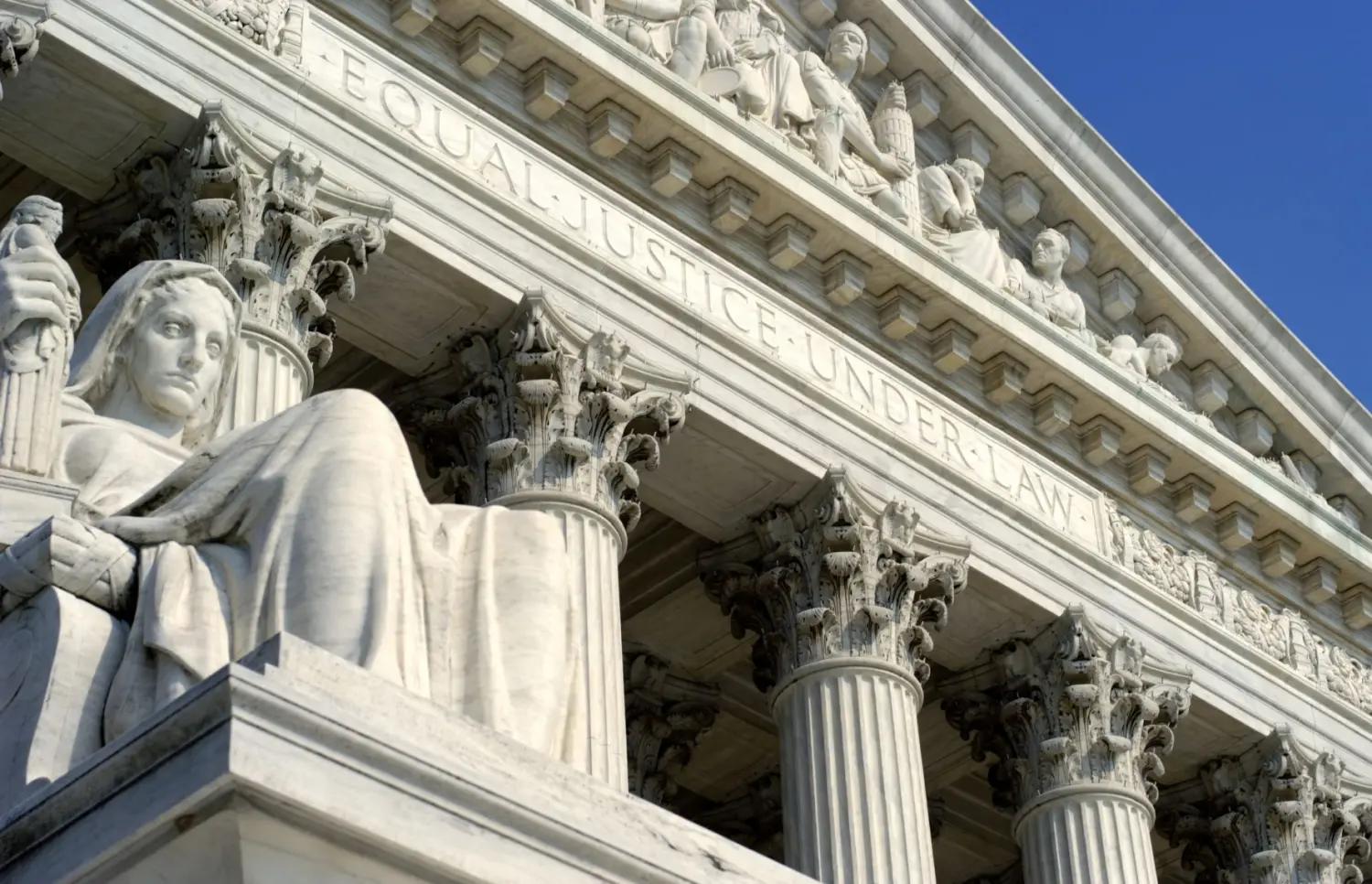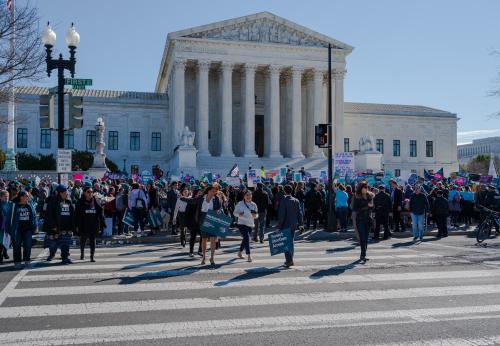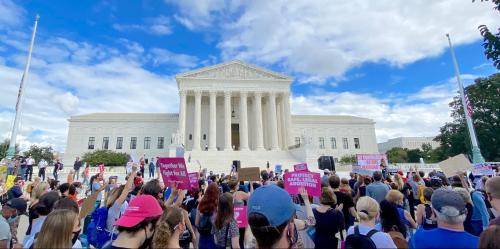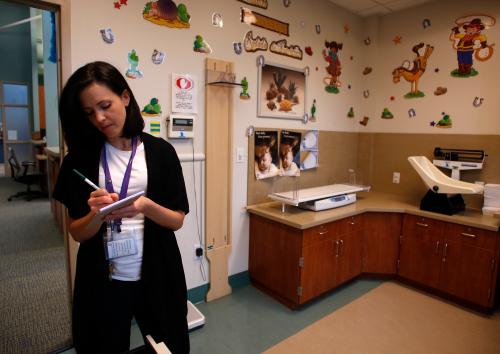Introduction
Two years after the Supreme Court overturned Roe v. Wade, abortion remains one of the most hotly contested issues in American politics. The abortion landscape has become highly fractured, with some states implementing abortion bans and restrictions and others increasing protections and access. The Supreme Court heard two more cases on abortion this term and will likely release those decisions in June. Beyond the Supreme Court, pro-choice and pro-life advocates are fiercely battling it out in the voting booths, state legislatures, and courts. If the 2022 midterm elections are any indication, abortion will be one of the most influential issues of the 2024 election. So what are the basic facts about abortion in America? This primer is designed to tell you most of what you need to know.
What are the different types of abortion?
There are two main types of abortion: procedural abortions and medication abortions. Procedural abortions (also called in-clinic or surgical abortions) are provided by health care professionals in a clinical setting. Medication abortions (also called medical abortions or the abortion pill) typically involve the oral ingestion of two drugs in succession, mifepristone and misoprostol.
Most women discover they are pregnant in the first five to six weeks of pregnancy, but about a third of women do not learn they are pregnant until they are beyond six weeks of gestation.1 Women with unintended pregnancies detect their pregnancies later than women with intended pregnancies, between six and seven weeks of gestation on average. Even if a woman discovers she is pregnant relatively early, for many it takes time to decide what to do and how to arrange for an abortion if that is her preference.
Why do women have abortions?
The vast majority of abortions (about 95%) are the result of unintended pregnancies. That includes pregnancies that are mistimed as well as those that are unwanted.
Women’s reasons for not wanting a child—or not wanting one now—include finances, partner-related issues, the need to focus on other children, and interference with future education or work opportunities.
In short, if there were fewer unintended pregnancies, there would be fewer abortions.
How common are abortions?
One in every four women will have an abortion in their lifetime.
About two in every five pregnancies are unintended (40% in 2015). Roughly the same share of these unintended pregnancies end in abortion (42% in 2011). About one in every five pregnancies are aborted (21% in 2020).
How have abortion totals changed over time?
The number of abortions occurring in the U.S. jumped up after the Roe v. Wade decision in 1973. After peaking in 1990, the number of abortions declined steadily for two and a half decades until reaching its lowest point since 1973 in 2017.2 Possible contributing factors explaining this long-term decline include delays in sexual activity amongst young people, improvements in the use of effective contraception, and overall declines in pregnancy rates, including those that are unintended. In addition, state restrictions which became more prevalent beginning in 2011 prevented at least some individuals in certain states from having abortions.
In 2018 (four years before the Supreme Court overturned Roe v. Wade), the number of abortions in the U.S. began to increase. The causes of this uptick are not yet fully understood, but researchers have identified multiple potential contributing factors. These include greater coverage of abortions under Medicaid that made abortions more affordable in certain states, regulations issued by the Trump administration in 2019 which decreased the size of the Title X network and therefore reduced the availability of contraception to low-income individuals, and increased financial support from privately-financed abortion funds to help pay for the costs associated with getting an abortion.
Another contributing factor, whose importance bears emphasizing, is the surging popularity of medication abortions.
The use of medication abortions has increased steadily since becoming available in the U.S. in 2000. However, in 2016, the FDA increased the gestational limit for the use of mifepristone from seven to ten weeks and thereby doubled the share of abortion patients eligible for medication abortions from 37% to 75%.
Later, during the COVID-19 pandemic, the FDA revised its policy in 2021 so that clinicians are no longer required to dispense medication abortion pills in person. Patients can now have medication abortion pills mailed to their homes after conducting remote consultations with clinicians via telehealth. In January 2023, the FDA issued another change which allows retail pharmacies like CVS and Walgreens to dispense medication abortion pills to patients with a prescription. Previously only doctors, clinics, or some mail-order pharmacies could dispense abortion pills.
Although access varies widely by state, medication abortions are now the most commonly used abortion method in the U.S. and account for nearly two-thirds of all abortions (63% in 2023).3
This is why the Supreme Court’s upcoming decision in the Mifepristone case (FDA v. Alliance for Hippocratic Medicine) is so consequential. Among other issues, at stake is whether access to medication abortion will be sharply curtailed and whether regulations regarding medication abortions will revert to pre-2016 rules when abortion pills were not authorized for use after seven weeks of pregnancy and could not be prescribed via telemedicine, sent to abortion patients by mail, or dispensed by retail pharmacies.
Who has abortions?
Most abortion patients are in their twenties (61%), Black or Latino (59%), low-income (72%), unmarried (86%), and between six and twelve weeks pregnant (73%).4
The majority of abortion patients have already given birth to one or more children (55%) and have not previously had an abortion (57%).5 Among abortion patients twenty years old or older, most had attended at least some college (63%). The vast majority of abortions occur during the first trimester of pregnancy (91%). So-called “late-term abortions” performed at or after 21 weeks of pregnancy are very rare and represent less than 1% of all abortions in the U.S.
The abortion rate per 1,000 women of reproductive age is disproportionately high for certain population groups. Among women living in poverty, for example, the abortion rate was 36.6 abortions per 1,000 women of reproductive age in 2014, compared to 14.6 abortions per 1,000 women among all women of reproductive age.
How much does an abortion cost?
The cost of an abortion varies depending on what kind of abortion is administered, how far along the patient is in their pregnancy, where the patient lives, where the patient is seeking an abortion, and whether health insurance or financial assistance is available. In 2021, the median self-pay cost for abortion services was $625 for a procedural abortion in the first trimester of pregnancy and $568 for a medication abortion.
Since 1977, the Hyde Amendment has banned the use of federal funds to pay for abortions except in cases of rape, incest, or life endangerment. Today, among the 36 states that have not banned abortion, fewer than half (17 as of March 2024) allow the use of state Medicaid funds to pay for abortions.6 Many insurance plans do not cover abortions, often due to state limitations. Most abortion patients pay for abortions out of pocket (53%). State Medicaid funding is the second-most-commonly used method of payment (30%), followed by financial assistance (15%) and private insurance (13%).7
Whether state law allows state Medicaid funds to cover abortions has a very large impact on the difficulty of paying for abortions and the methods used by women to pay for them. In the year before the Dobbs Supreme Court decision, 50% of women residing in states where state Medicaid funds did not cover abortion reported it was very or somewhat difficult to pay for their abortions, compared to only 17% of women residing in states where abortions were covered.
How has the Supreme Court handled abortion?
In Roe v. Wade (1973), the Supreme Court established that states could not ban abortions before fetal viability, the point at which a fetus can survive outside the womb. Under the three-trimester framework established by Roe, states were not allowed to ban abortions during the first two trimesters of pregnancy but were allowed to regulate or prohibit abortions in the third trimester, except in cases where abortions were necessary to protect the life or health of a pregnant person. The Court ruled that the fundamental right to have an abortion is included in the right to privacy implicit in the “liberty” guarantee of the Due Process Clause of the Fourteenth Amendment.
Since it was decided, Roe v. Wade has faced legal criticism. Notwithstanding these critiques, the Court upheld Roe multiple times over the next half-century including in Planned Parenthood v. Casey (1992). But after former President Trump appointed three new Justices to the Supreme Court, a new conservative supermajority overturned Roe v. Wade in Dobbs v. Jackson Women’s Health Organization (2022) and established that there is no Constitutional right to have an abortion.
In his Dobbs majority opinion, Justice Alito concluded “Roe was egregiously wrong from the start.” Writing for the majority, he underscored that “[t]he Constitution makes no reference to abortion,” and while he recognized there are constitutional rights not expressly enumerated in the Constitution, he concluded the right to have an abortion is not one of them. Justice Alito reasoned that the only legitimate rights not explicitly stated in the Constitution are those “deeply rooted in the nation’s history and traditions,” and he found no evidence of this for abortion.
Because the Court determined there is no Constitutional right to abortion, it allowed the Mississippi state law which banned abortion after 15 weeks of pregnancy with limited exceptions to go into effect. The Court ruled that states have the authority to restrict access to abortion or ban it completely and that the power to regulate or prohibit abortions would be “returned to the people and their elected representatives.”
The Court’s three liberal Justices criticized the majority’s decision in a withering joint dissent. The dissenting Justices argued the right to abortion established in Roe and upheld in Casey is necessary to respect the autonomy and equality of women and prevent the government from controlling “a woman’s body or the course of a woman’s life.” They lamented “one result of today’s decision is certain: the curtailment of women’s rights, and of their status as free and equal citizens.”
How did the states respond to the overturning of Roe v. Wade?
Since Roe v. Wade was overturned, many states have implemented abortion bans or restrictions, while others have added protections and expanded access. The abortion landscape in America is now fractured and highly variegated.
As of May 2024, abortion is banned completely in almost all circumstances in 14 states. In 7 states, abortion is banned at or before 18 weeks of gestation. Many states with abortion bans do not include exceptions in cases where the health of the pregnant person is at risk, the pregnancy is the result of rape or incest, or there is a fatal fetal anomaly.
Access to abortion varies widely even among states without bans since many states have restrictions such as waiting periods, gestational limits, or parental consent laws making it more difficult to get an abortion.
Many state bans and restrictions are still being litigated in court. The interjurisdictional issues and legal questions arising from the post-Dobbs abortion landscape have not been fully resolved.
Despite the Supreme Court’s stated intention in Dobbs to leave the abortion issue to elected officials, the Court will likely hear more cases on abortion in the near future. This term, in addition to the case about Mifepristone, the Court will decide in Moyle v. United States whether a federal law called the Emergency Medical Treatment and Labor Act (EMTLA) can require hospitals in states with abortion bans to perform abortions in emergency situations that demand “stabilizing treatment” for the health of pregnant patients.
What are the trends in abortion statistics post-Dobbs?
In 2023, the first full year since the Dobbs Supreme Court decision, states with abortion bans experienced sharp declines in the number of abortions occurring within their borders. But these declines were outweighed by increases in abortion totals in states where abortion remained legal. Nearly all states without bans witnessed increases in 2023. Taken together, abortions in non-ban states increased by 26% in 2023 compared to 2020 levels.
As a result, the nationwide abortion statistics from 2023 represent the highest total number (1,037,000 abortions) and abortion rate (15.9 abortions per 1,000 women of reproductive age) in the U.S. in over a decade. The 2023 U.S. total represents an 11% increase from 2020 levels.
It’s unclear why, despite Dobbs, abortions have continued to rise. It may be because of the increased use of medication abortions, especially after the FDA liberalized regulations related to telehealth and in-person visits. In addition, multiple states where abortion remains legal have implemented shield laws and other new protections for abortion patients and providers, increased insurance coverage, or otherwise expanded access. Abortion funds provided greater financial and practical assistance. Interstate travel for abortions doubled after the Dobbs decision.
In short, the impacts of Dobbs are being felt unevenly. Although most women who want abortions are still able to obtain them, a significant minority are instead carrying their pregnancies to term. In the first six months of 2023, state abortion bans led between one-fifth and one-fourth of women living in ban states who may have otherwise gotten an abortion not to have one.
Young, low-income, and minority women will be most affected by state bans and restrictions because they are disproportionately likely to have unintended pregnancies and less able to overcome economic and logistical barriers involved in travelling across state lines or receiving medication abortion pills through out-of-state networks.
What are the effects of expanding or restricting abortion access on women and their families?
Effects of abortion restrictions on women
Abortion bans jeopardize the lives and health of women. The impacts on their health can be especially troublesome. Pregnancies can go wrong for many reasons—fetal abnormalities, complications of a miscarriage, ectopic pregnancies—and without access to emergency care, some women could face serious threats to their own health and future ability to bear children. Abortion restrictions can place doctors in difficult situations and undermine women’s health care.
Although medication abortions are safe and effective, abortion bans could also increase the number of women who use unsafe methods to induce self-managed abortions, thereby endangering their own health or even their lives. State abortion legalizations in the years before Roe reduced maternal mortality among non-white women by 30-40%.
Enforcement of state laws that restricted access to abortion in the years before Dobbs has even been associated with increases in intimate partner violence-related homicides of women and girls.
In addition, lack of access to abortion leads to worse economic outcomes for women. After a conservative group suggested that such effects have not been well documented, a group of economists filed an amicus brief to the Supreme Court in the Dobbs case, noting that in recent years methods for establishing the causal effects of abortion have shown that they do affect women’s life trajectories. Although there has been some difficulty in separating the effects of access to abortion from access to the Pill or other forms of birth control, an extensive literature shows that reducing unintended pregnancies increases educational attainment, labor force participation, earnings, and occupational prestige for women. These trends are especially pronounced for Black women.
One example that focuses solely on abortion is the Turnaway study, in which researchers compared the outcomes for women who were denied abortions on the basis of just being a little beyond the gestational cutoff for eligibility to the outcomes of otherwise similar women who were just under that cutoff. The study along with subsequent related research has shown that women who are denied abortions are nearly four times more likely to be living in poverty six months after being denied an abortion, a difference that persists through four years after denial. They are also more likely to be unemployed, rely on public assistance, and experience financial distress such as bankruptcies, evictions and court judgements.
Finally, increased access to abortion results in lower rates of single and teen parenthood. State abortion legalizations in the years before Roe reduced the number of teen mothers by 34%. The effects were especially large for Black teens.
Effects of abortion restrictions on children
Along with contraception, access to abortion reduces unplanned births. That means fewer children dying in infancy, growing up in poverty, needing welfare, and living with a single parent. One study suggests that if all currently mistimed births were aligned with the timing preferred by their mothers, children’s college graduation rates would increase by about 8 percentage points (a 36% increase), and their lifetime incomes would increase by roughly $52,000.
Despite this evidence that the denial of abortions to women who want them would be harmful to women and to children once born, those who are pro-life argue that these costs are well worth the price to save the lives of the unborn. As of April 2024, 36% of Americans believe abortion should be illegal in all (8%) or most (28%) cases, while 63% of Americans believe abortion should be legal in all (25%) or most (28%) cases.
Looking ahead
The abortion landscape in America is continually evolving. Whereas pro-choice advocates will seek to expand access and add additional protections for abortion patients and providers, opponents of abortion will continue to criminalize abortions and further restrict availability.
Abortion will be one of the top issues of the 2024 elections in November. Democratic candidates in particular believe abortion is a winning issue for them and will broadcast their pro-choice stance on the campaign trail. Some evidence suggests the overturning of Roe has galvanized a new class of abortion-rights voters. Multiple states will have abortion referenda on the ballot.
The Supreme Court’s Dobbs decision will not prevent women and other citizens from affecting the legislative process by voting, organizing, influencing public opinion, or running for office. What they do with that power in November remains to be seen.
-
Acknowledgements and disclosures
The Brookings Institution is financed through the support of a diverse array of foundations, corporations, governments, individuals, as well as an endowment. A list of donors can be found in our annual reports published online here. The findings, interpretations, and conclusions in this report are solely those of its author(s) and are not influenced by any donation.
-
Footnotes
- We recognize people of all genders become pregnant and have abortions, including about 1% of abortion patients who do not identify as women or female. For concision, we use “women” and female pronouns in this piece when discussing individuals who become pregnant.
- The Guttmacher and CDC data produced in this primer only represent legal abortions that occur within the formal US healthcare system. They do not include self-managed which occur outside of the formal US healthcare system.
- As of March 2024, 29 states have laws that restrict access to medication abortion, for example by requiring ultrasound, counseling, or multiple in-person appointments.
- We define low-income as earnings below 200% of the federal poverty level.
- The CDC abortion data is less complete than the Guttmacher Institute data and omits abortion data from states which account for approximately one-fourth of all abortions in the U.S.
- Today, roughly 35% of women of reproductive age covered by Medicaid (5.5 million women) are living in states where abortion is legal but state funds are not allowed to cover abortions beyond the Hyde exceptions of rape, incest, or life endangerment.
- Respondents could indicate multiple payment methods.







